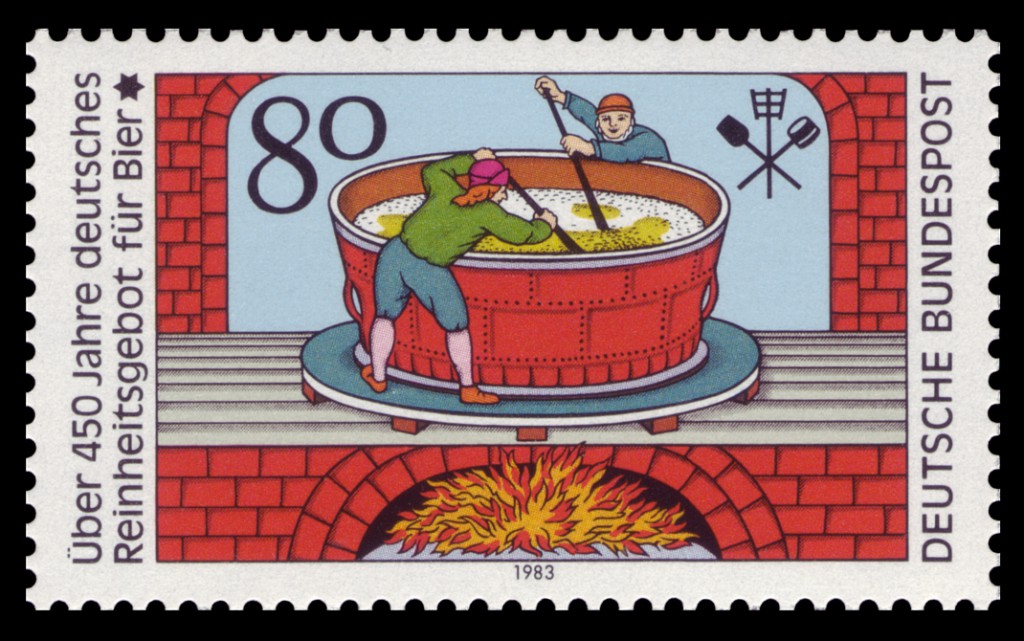This is part of my series to discuss 500 years of Reinheitsgebot.
The 23rd of April is getting closer, and more media is starting to be interested in and report about the Reinheitsgebot. FAZ, one of Germany’s largest and most influential newspapers, started a blog about beer and the Reinheitsgebot.
In the latest article, they write about Schlenkerla, the classic Franconian brewery from Bamberg that produces a rather unique and tasty smoked beer. They also portray Matthias Trum, member of the family that owns the brewery, who has a background in brewing history at the Technical University of Munich in Weihenstephan (here’s the outcome of his diploma thesis). The end of the article contains a paragraph, written by Matthias Trum himself, about his position regarding the Reinheitsgebot. I’ll try to translate it here:
On a first glance, the purity law limits the possibilities of a brewer. In my opinion, you can’t forget that our, i.e. the Bavarian resp. the German understanding of what beer is, is based on this 500 year old law. If a brewer nowadays wants to produce a fermented barley drink with cherry flavour, then it may be an interesting drink, but it doesn’t conform to our grown understanding of beer. I’d find it a pity if such an old tradition like the purity law, even with all legitimate criticism, would be sacrificed to a modern and maybe only temporary trend. The solution would actually be quite simple: where beer is printed on the label, purity law must be in it. If somebody wants to brew anything else, they need to call it differently. Brewers and public authorities/legislative authority/EU would only need to agree.
Well, to put it mildly, this is infuriating. I’m especially appalled by how Matthias Trum, who has a background in beer history, can spout such completely ahistorical nonsense. As I’ve shown before, people in Germany, even Bavaria, have brewed plenty of beer in the last 500 years that doesn’t conform to the purity law at all. Even though a minimalistic understanding of beer as only containing malt, hops, water, and yeast may have been prevalent in Bavaria, it doesn’t reflect reality. And even if you accepted this minimalism as premise, it still doesn’t apply to the rest of Germany until about 110 years ago.
Brewing with other ingredients, such as juniper, marjoram, thyme, oregano, elderflowers, fir tips, birch tips, rose hips, cream of tartar, honey, ginger, gentian roots, bitter oranges, lemons, cardamom, rice, and salt, was common all over Germany. That was the understanding of beer in much of Germany from the 16th to the end of the 19th century. And it’s a sign of a rich and diverse brewing culture. When Matthias Trum claims that “our” understanding – I assume he’s implying the German understanding – of beer is equal to the Bavarian minimalism, then this is not only ahistorical, it tries to erase this rich and diverse German brewing culture outside of Bavaria with a relatively recent trend: pale lager beers only started being produced in Vienna in 1840 and Bohemia in 1842, while in Bavaria, dark lagers were prevalent until the end of the 19th century. Only in 1895, Helles started being served in Munich.
And that is one issue that I have with Matthias Trum’s statement: it claims “tradition” for a relatively recent trend in beer brewing, and it claims “tradition” for beer styles that weren’t even brewed or served in Germany for the majority of the last 500 years.
But it’s part of a pattern that I noticed: Bavarians try to claim the prerogative on how beer is meant to be, and try to force their narrow and minimalistic definition onto everyone else in Germany. I called this the Bavarian Beer Chauvinism. I find this chauvinism particularly heinous because it claims tradition where there is none, it built up a narrative that is not backed up by historical accounts, and at the same time, denies the existence of most of Germany’s brewing culture, at best it draws a distorted picture that beer over 500 years ago was only brewed with bad ingredients or other such nonsense.
Matthias Trum’s suggestion at the end shows exactly that: he’d like to deny using the term “beer” to everyone that refuses to adhere to the Bavarian minimalism. Very broadly and drastically interpreted, this could mean the end of beer in Germany imported from other countries with rich and diverse brewing traditions in Europe: plenty of English beer doesn’t conform to the purity law, as does a lot of Belgian beer, and most likely many brewing traditions, as well. And it’s not just about the straw-man “cherry beer” that Matthias Trum is attacking, there are lots of ingredients that are perfectly safe for brewing that would help brewers in creating new, exciting beers, or even just allow the recreation of historical German beers.
I, for one, would like to see Matthias Trum and his Schlenkerla brewery to recreate a historic Bavarian beer such as Farrnbacher beer, as it was brewed in the first half of the 19th century, and then he will realize how nonsensical the purity law is, and how harmful it actually is both to the history and the future of German brewing.

